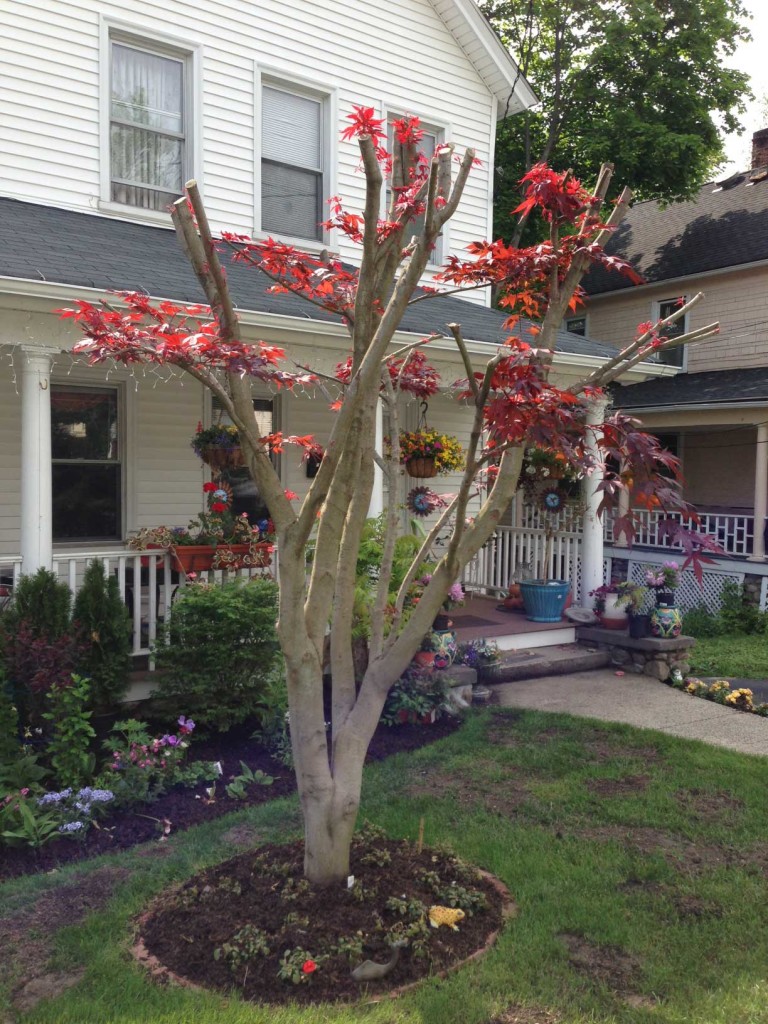Written by Monica Hemingway and published on https://pruningguide.com/
Topping trees is an overused, crude pruning strategy where the Arborist cuts all the major branches such that blunt ends are left without any secondary branches left to assume the dominance. Topping is not an acceptable pruning method and should rarely or never be used. Yet, it is very common among inexperienced tree services. Topping trees not only diminishes the tree’s overall aesthetics, but has serious negative repercussions for the tree’s structural integrity.
Tree Topping: What, Why and Why Not

This topped maple tree was twice the size the following summer.
What is Topping?
Topping is the practice of drastically cutting back all of a tree’s larger branches at a random point to make them shorter. The result is a tree with large, stubby branches sticking out in all directions.
Effects of Tree Topping
Topping a tree is often sold to the homeowner as a way to reduce the size of the tree, open up the view, and make it safer.
The reality is the exact opposite.
After topping, the tree will quickly grow back to the same size (or even larger) but will have lost its natural shape (the word “ugly” comes to mind) and the new growth will be weaker and poorly attached to the trunk (making the tree more dangerous). Add to that the fact that the large, non-selective heading cuts made when topping the tree don’t heal well (leading to rot, disease, and insect infestations) and you have a recipe for disaster.
The Costs of Topping
While the initial removal of tree branches through topping is often less expensive than proper pruning, the long-term costs far outweigh the supposed savings. Here are the typical results of tree topping and the associated costs.
- The Tree Keeps Growing – Fast: Topping doesn’t keep trees small. Instead, it promotes the growth of water sprouts (thin branches that grow straight upward) that grow 4 to 10 times faster than normal branches. And they multiply exponentially each time they’re cut off. The end result is an endless cycle of topping every year to keep the tree in check. More money for the person doing the topping, less money for you.
- A More Dangerous Tree: Water sprouts are weakly attached to the branch, meaning that they’re likely to break off as they grow larger. This is made worse by the cut branch rotting at the end where the water sprouts appear (due to the non-selective heading cut). The end result? Branches falling off for no apparent reason. Think of the increased liability and insurance costs if those branches fall on something or (God forbid) someone.
- An Ugly Tree: Remember those trees you drew in kindergarten? The ones with a round green circle on a brown stick? Trees aren’t meant to look like that. But that’s what topping does. The tree looses all of its natural form and it will never come back. That doesn’t do good things to your property value.
- Increased Disease and Insect Problems: Topped branches have large wounds that don’t heal properly. Rot sets in, moves down the branch, and leaves an open door for disease and insect infestation. So now you’re paying for tree inspections and spraying to try to keep it healthy. Eventually, the branch dies and in some cases, so does the tree.
- A Dead Tree: Some trees simply can’t tolerate topping. By removing much of the foliage, the tree cannot make enough “food” to sustain itself. Within one growing season you have a dead tree. And it’s not cheap to remove and/or replace a mature tree.
Original post here https://ift.tt/3ixc3oA.
from AAA Tree Lopping Ipswich https://ift.tt/3zqyxO7
via IFTTT
No comments:
Post a Comment